原因、结果、目的状语从句讲解和练习和答案
高中英语状语从句讲解及配 套练习
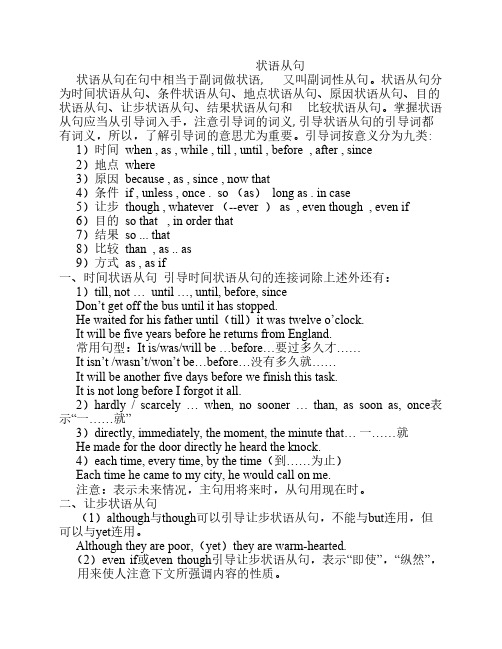
状语从句状语从句在句中相当于副词做状语, 又叫副词性从句。
状语从句分为时间状语从句、条件状语从句、地点状语从句、原因状语从句、目的状语从句、让步状语从句、结果状语从句和 比较状语从句。
掌握状语从句应当从引导词入手,注意引导词的词义,引导状语从句的引导词都有词义,所以,了解引导词的意思尤为重要。
引导词按意义分为九类: 1)时间 when , as , while , till , until , before , after , since2)地点 where3)原因 because , as , since , now that4)条件 if , unless , once . so (as) long as . in case5)让步 though , whatever (--ever ) as , even though , even if6)目的 so that , in order that7)结果 so ... that8)比较 than , as .. as9)方式 as , as if一、时间状语从句引导时间状语从句的连接词除上述外还有:1)till, not … until …, until, before, sinceDon’t get off the bus until it has stopped.He waited for his father until(till)it was twelve o’clock.It will be five years before he returns from England.常用句型:It is/was/will be …before…要过多久才……It isn’t /wasn’t/won’t be…before…没有多久就……It will be another five days before we finish this task.It is not long before I forgot it all.2)hardly / scarcely … when, no sooner … than, as soon as, once表示“一……就”3)directly, immediately, the moment, the minute that… 一……就He made for the door directly he heard the knock.4)each time, every time, by the time(到……为止)Each time he came to my city, he would call on me.注意:表示未来情况,主句用将来时,从句用现在时。
初中英语状语从句讲解及典型例题
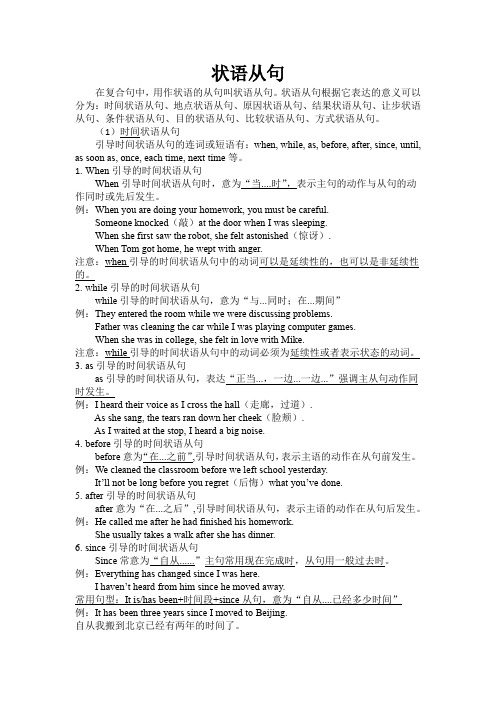
状语从句在复合句中,用作状语的从句叫状语从句。
状语从句根据它表达的意义可以分为:时间状语从句、地点状语从句、原因状语从句、结果状语从句、让步状语从句、条件状语从句、目的状语从句、比较状语从句、方式状语从句。
(1)时间状语从句引导时间状语从句的连词或短语有:when, while, as, before, after, since, until, as soon as, once, each time, next time等。
1.When引导的时间状语从句When引导时间状语从句时,意为“当....时”,表示主句的动作与从句的动作同时或先后发生。
例:When you are doing your homework, you must be careful.Someone knocked(敲)at the door when I was sleeping.When she first saw the robot, she felt astonished(惊讶).When Tom got home, he wept with anger.注意:when引导的时间状语从句中的动词可以是延续性的,也可以是非延续性的。
2.while引导的时间状语从句while引导的时间状语从句,意为“与...同时;在...期间”例:They entered the room while we were discussing problems.Father was cleaning the car while I was playing computer games.When she was in college, she felt in love with Mike.注意:while引导的时间状语从句中的动词必须为延续性或者表示状态的动词。
3.as引导的时间状语从句as引导的时间状语从句,表达“正当...,一边...一边...”强调主从句动作同时发生。
状语从句讲解及练习
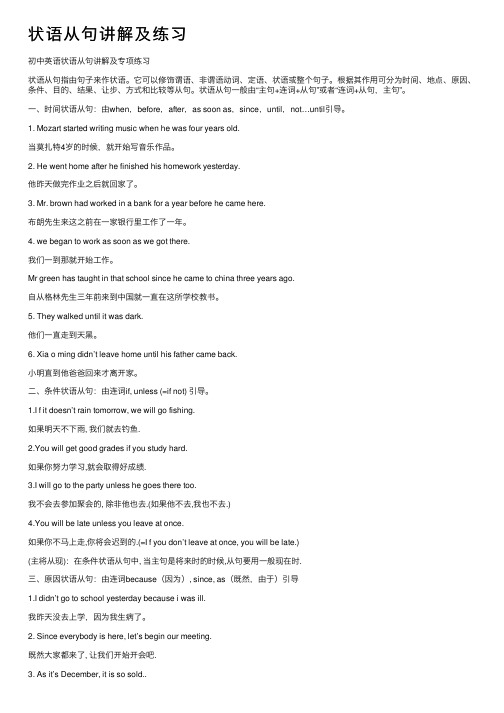
状语从句讲解及练习初中英语状语从句讲解及专项练习状语从句指由句⼦来作状语。
它可以修饰谓语、⾮谓语动词、定语、状语或整个句⼦。
根据其作⽤可分为时间、地点、原因、条件、⽬的、结果、让步、⽅式和⽐较等从句。
状语从句⼀般由“主句+连词+从句”或者“连词+从句,主句”。
⼀、时间状语从句:由when,before,after,as soon as,since,until,not…until引导。
1. Mozart started writing music when he was four years old.当莫扎特4岁的时候,就开始写⾳乐作品。
2. He went home after he finished his homework yesterday.他昨天做完作业之后就回家了。
3. Mr. brown had worked in a bank for a year before he came here.布朗先⽣来这之前在⼀家银⾏⾥⼯作了⼀年。
4. we began to work as soon as we got there.我们⼀到那就开始⼯作。
Mr green has taught in that school since he came to china three years ago.⾃从格林先⽣三年前来到中国就⼀直在这所学校教书。
5. They walked until it was dark.他们⼀直⾛到天⿊。
6. Xia o ming didn’t leave home until his father came back.⼩明直到他爸爸回来才离开家。
⼆、条件状语从句:由连词if, unless (=if not) 引导。
1.I f it doesn’t rain tomorrow, we will go fishing.如果明天不下⾬, 我们就去钓鱼.2.You will get good grades if you study hard.如果你努⼒学习,就会取得好成绩.3.I will go to the party unless he goes there too.我不会去参加聚会的, 除⾮他也去.(如果他不去,我也不去.)4.You will be late unless you leave at once.如果你不马上⾛,你将会迟到的.(=I f you don’t leave at once, you will be late.)(主将从现):在条件状语从句中, 当主句是将来时的时候,从句要⽤⼀般现在时.三、原因状语从句:由连词because(因为), since, as(既然,由于)引导1.I didn’t go to school yesterday because i was ill.我昨天没去上学,因为我⽣病了。
初中结果状语从句和目的状语从句讲解以及习题(适合基础差的同学
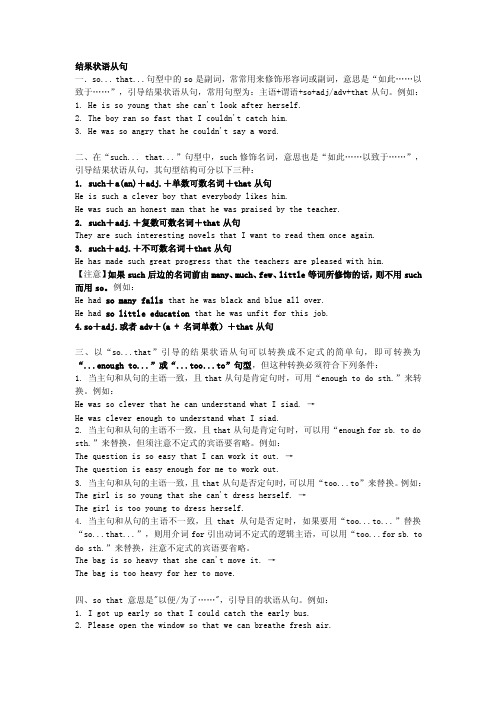
结果状语从句一.so... that...句型中的so是副词,常常用来修饰形容词或副词,意思是“如此……以致于……”,引导结果状语从句,常用句型为:主语+谓语+so+adj/adv+that从句。
例如:1. He is so young that she can't look after herself.2. The boy ran so fast that I couldn't catch him.3. He was so angry that he couldn't say a word.二、在“such... that...”句型中,such修饰名词,意思也是“如此……以致于……”,引导结果状语从句,其句型结构可分以下三种:1. such+a(an)+adj.+单数可数名词+that从句He is such a clever boy that everybody likes him.He was such an honest man that he was praised by the teacher.2. such+adj.+复数可数名词+that从句They are such interesting novels that I want to read them once again.3. such+adj.+不可数名词+that从句He has made such great progress that the teachers are pleased with him.【注意】如果such后边的名词前由many、much、few、little等词所修饰的话,则不用such 而用so。
例如:He had so many falls that he was black and blue all over.He had so little education that he was unfit for this job.4.so+adj.或者adv+(a + 名词单数)+that从句三、以“so...that”引导的结果状语从句可以转换成不定式的简单句,即可转换为“...enough to...”或“...too...to”句型,但这种转换必须符合下列条件:1. 当主句和从句的主语一致,且that从句是肯定句时,可用“enough to do sth.”来转换。
高中英语状语从句用法解析(含练习和答案)

高中英语状语从句用法解析英语语法状语从句类型综述状语从句主要用来修饰主句或主句的谓语。
一般可分为九大类,分别表示时间、地点、原因、目的、结果、条件、让步、比较和方式。
尽管种类较多,但由于状语从句与汉语结构和用法相似,所以理解和掌握它并不难。
状语从句的关键是要掌握引导不同状语从句的常用连接词和特殊的连接词即考点。
现分别列举如下:1.时间状语从句常用引导词:when, as, while, as soon as, while, before, after, since , till, until特殊引导词:the minute, the moment, the second, every time, the day,the instant, immediately , directly, no sooner … than, hardly …when, scarcely … whenI didn’t realize how special my mother was until I became an adult.While John was watching TV, his wife was cooking.The children ran away from the orchard(果园) the moment they saw the guard.No sooner had I arrived home than it began to rain.Every time I listen to your advice, I get into trouble.2.地点状语从句常用引导词:where特殊引导词:wherever, anywhere, everywhereGenerally, air will be heavily polluted where there are factories.Wherever you go, you should work hard.3.原因状语从句常用引导词:because, since, as, since特殊引导词:seeing that, now that, in that, considering that, given that, considering that, inasmuch as, insomuch asMy friends dislike me because I’m handsome and successful.Now that everybody has come, let’s begin our conference.The higher income tax is harmful in that it may discourage people from trying to earn more.Considering that he is no more than 12 years old, his height of 1.80 m is quite remarkable.4.目的状语从句常用引导词:so that, in order that特殊引导词:lest, in case, for fear that,in the hope that, for the purpose that, to the end thatThe boss asked the secretary to hurry up with the letters so that he could sign them.The teacher raised his voice on purpose that the students in the back could hear more clearly.5.结果状语从句常用引导词:so … that, so… that, such … that,特殊引导词:such that, to the degree that, to the extent that, to such a degree that,He got up so early that he caught the first bus.It’s such a good chance that we must not miss it.To such an degree was he excited that he couldn’t sleep last night.6.条件状语从句常用引导词:if, unless,特殊引导词:as/so long as, only if, providing/provided that, suppose that, in case that, on condition thatWe’ll start our project if the president agrees.You will certainly succeed so long as you keep on trying.Provided that there is no opposition, we shall hold the meeting here.7.让步状语从句常用引导词:though, although, even if, even though特殊引导词:as(用在让步状语从句中必须要倒装),while ( 一般用在句首),no matter …,in spite of the fact that, while, whatever, whoever, wherever, whenever, however, whicheverMu ch as I respect him, I can’t agree to his proposal.尽管我很尊敬他,我却不同意他的建议。
(完整版)高考英语专题复习状语从句(附答案)

高考英语专题复习状语从句(附答案)I. 考点分析状语从句可用来表示时间、地点、原因、目的、结果、条件、方式、比较和让步等。
1.时间状语从句1) 常见关联词有when, whenever, while, as, before, after 等。
2)注意not…until… 正常结构、倒装结构、强调结构、和until置于句首的用法。
He didn’t go to sleep until he had finished his homework. (正常结构)Not until he had finished his homework did he go to sleep. (倒装结构)It was not until he had finished his homework that he went to sleep.(强调结构)Until he had finished his homework he didn’t go to sleep. (until置于句首)3)表示“一……就……”的连词:once, as soon as, hardly/scarcely…when, no sooner…than, the minute, the moment, the instant, immediately, directly, instantly4)其他表示时间的短语还有:every time, next time, the day 等。
2.地点状语从句通常由where, wherever引导如:Where there is a will, there is a way.3.原因状语从句1) 通常由because, as ,since引导, 三者区别:because 语气最强,重在交待原因,以why引导的疑问句只能because用来回答;其前可用only, just等词强调;可用在It is…that…强调句型中。
状语从句讲解及练习题50题-有答案
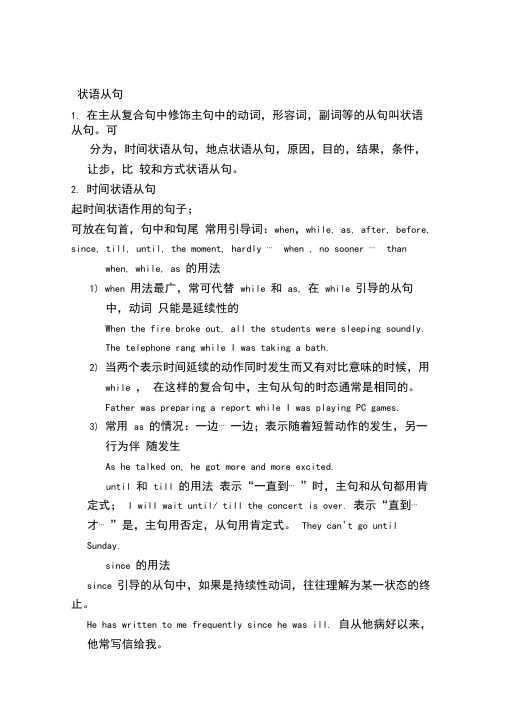
状语从句1.在主从复合句中修饰主句中的动词,形容词,副词等的从句叫状语从句。
可分为,时间状语从句,地点状语从句,原因,目的,结果,条件,让步,比较和方式状语从句。
2.时间状语从句起时间状语作用的句子;可放在句首,句中和句尾常用引导词:when,while, as, after, before, since, till, until, the moment, hardly ⋯when , no sooner ⋯than when, while, as 的用法1)when 用法最广,常可代替while 和as, 在while 引导的从句中,动词只能是延续性的When the fire broke out, all the students were sleeping soundly.The telephone rang while I was taking a bath.2)当两个表示时间延续的动作同时发生而又有对比意味的时候,用while ,在这样的复合句中,主句从句的时态通常是相同的。
Father was preparing a report while I was playing PC games.3)常用as 的情况:一边⋯一边;表示随着短暂动作的发生,另一行为伴随发生As he talked on, he got more and more excited.until 和till 的用法表示“一直到⋯”时,主句和从句都用肯定式;I will wait until/ till the concert is over. 表示“直到⋯才⋯”是,主句用否定,从句用肯定式。
They can't go untilSunday.since 的用法since 引导的从句中,如果是持续性动词,往往理解为某一状态的终止。
He has written to me frequently since he was ill. 自从他病好以来,他常写信给我。
(完整版)初中结果状语从句讲解与练习(包含中考题以及答案)
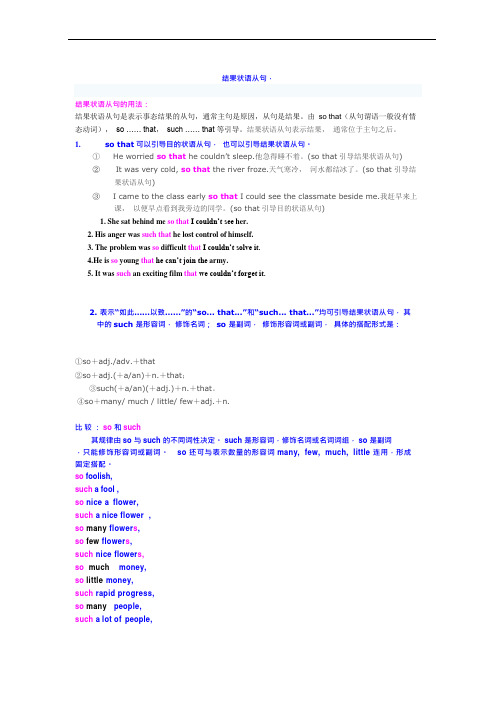
结果状语从句,结果状语从句的用法:结果状语从句是表示事态结果的从句,通常主句是原因,从句是结果。
由so that(从句谓语一般没有情态动词),so …… that,such …… that 等引导。
结果状语从句表示结果,通常位于主句之后。
1.so that 可以引导目的状语从句,也可以引导结果状语从句。
①He worried so that he couldn’t sleep.他急得睡不着。
(so that 引导结果状语从句)②It was very cold, so that the river froze.天气寒冷,河水都结冰了。
(so that 引导结果状语从句)③I came to the class early so that I could see the classmate beside me.我赶早来上课,以便早点看到我旁边的同学。
(so that 引导目的状语从句)1.She sat behind me so that I couldn’t see her.2.His anger was such that he lost control of himself.3.The problem was so difficult that I couldn’t solve it.4.He is so young that he can’t join the army.5. It was such an exciting film that we couldn’t forget it.2. 表示“如此……以致……”的“so... that...”和“such... that...”均可引导结果状语从句,其中的such 是形容词,修饰名词;so 是副词,修饰形容词或副词,具体的搭配形式是:①so+adj./adv.+that②so+adj.(+a/an)+n.+that;③such(+a/an)(+adj.)+n.+that。
2020届高三高考英语复习语法讲解及练习题:状语从句【含答案】
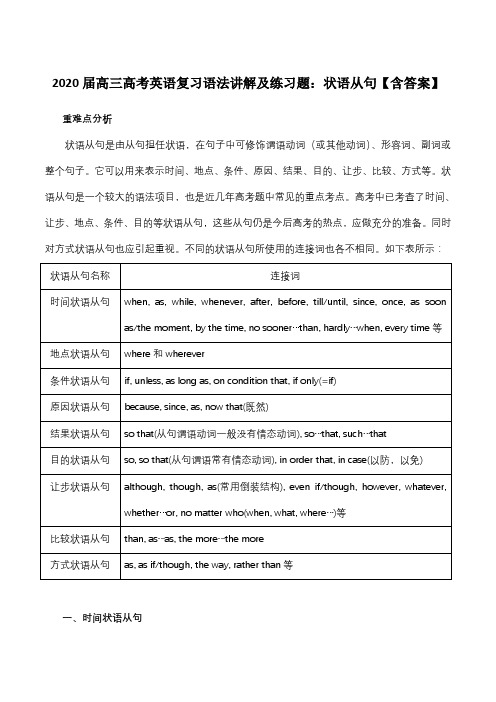
2020届高三高考英语复习语法讲解及练习题:状语从句【含答案】重难点分析状语从句是由从句担任状语,在句子中可修饰谓语动词(或其他动词)、形容词、副词或整个句子。
它可以用来表示时间、地点、条件、原因、结果、目的、让步、比较、方式等。
状语从句是一个较大的语法项目,也是近几年高考题中常见的重点考点。
高考中已考查了时间、让步、地点、条件、目的等状语从句,这些从句仍是今后高考的热点,应做充分的准备。
同时对方式状语从句也应引起重视。
不同的状语从句所使用的连接词也各不相同。
如下表所示:状语从句名称连接词时间状语从句when, as, while, whenever, after, before, till/until, since, once, as soon as/the moment, by the time, no sooner…than, hardly…when, every time等地点状语从句where和wherever条件状语从句if, unless, as long as, on condition that, if only(=if)原因状语从句because, since, as, now that(既然)结果状语从句so that(从句谓语动词一般没有情态动词), so…that, such…that目的状语从句so, so that(从句谓语常有情态动词), in order that, in case(以防,以免)让步状语从句although, though, as(常用倒装结构), even if/though, however, whatever, whether…or, no matter who(when, what, where…)等比较状语从句than, as…as, the more…the more方式状语从句as, as if/though, the way, rather than等一、时间状语从句1. while, when, as引导时间状语从句时的区别(1) while引导的状语从句中谓语动词必须是持续性动词。
原因、结果、目的状语从句讲解和练习测试和参考答案
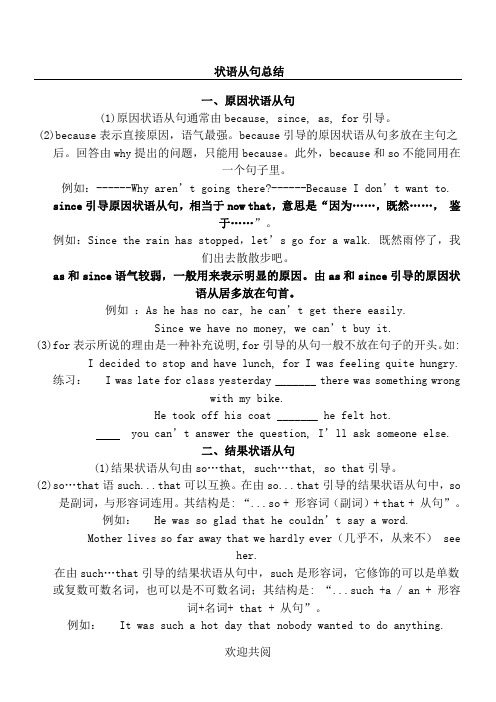
状语从句总结一、原因状语从句(1)原因状语从句通常由because, since, as, for引导。
(2)because表示直接原因,语气最强。
because引导的原因状语从句多放在主句之后。
回答由why提出的问题,只能用because。
此外,because和so不能同用在一个句子里。
例如:------Why aren’t going there?------Because I don’t want to.since引导原因状语从句,相当于now that,意思是“因为……,既然……,鉴于……”。
例如:Since the rain has stopped,let’s go for a walk. 既然雨停了,我们出去散散步吧。
as和since语气较弱,一般用来表示明显的原因。
由as和since引导的原因状语从居多放在句首。
例如:As he has no car, he can’t get there easily.Since we have no money, we can’t buy it.(3)for表示所说的理由是一种补充说明,for引导的从句一般不放在句子的开头。
如:I decided to stop and have lunch, for I was feeling quite hungry.练习:I was late for class yesterday _______ there was something wrongwith my bike.He took off his coat _______ he felt hot.you can’t answer the question, I’ll ask s omeone else.二、结果状语从句(1)结果状语从句由so…that, such…that, so that引导。
(2)so…that语such...that可以互换。
状语从句及练习附答案

状语从句(adverbial clause)复习要点:掌握句法功能,记住连接词语法意义:状语从句是复合句中的一种,整个从句作主句的状语,修饰主句中的谓语动词、形容词、或副词。
置于句首时,状语从句后面一般要有逗号隔开;如果状语从句置于句尾,则从句一般不用逗号。
按照所作的状语和意义可分为时间、地点、原因、目的、结果、条件、让步、方式和比较等九种状语从句。
具体如下:一、时间状语从句(Adverbial Clauses of Time)时间状语从句通常由when,whenever,as,while,before,after,assoon as,since,once,no sooner...then,hardly/scarcely...when,tiLl/until 以及the moment,directly,immediately,the second,thefirst time,next time,every time,等引导。
1.由when,as,while 引导的状语从句:1)when 引导时间状语从句,表示当···,其谓语动词可以是延续性的,也可以是非延续性的,其作用最广泛。
When spring comes,trees turn green,When it rains,I usually go to work by taxi.When we were having lunch,the light went out.I will ring you up when I return.When she pressed the button,the lift stopped.He was eating his breakfast when the doorbell rang.be about to do...when...“就在那/这时,(突然)另一个动作发生了,在这儿只能用when。
高中英语状语从句练习与讲解
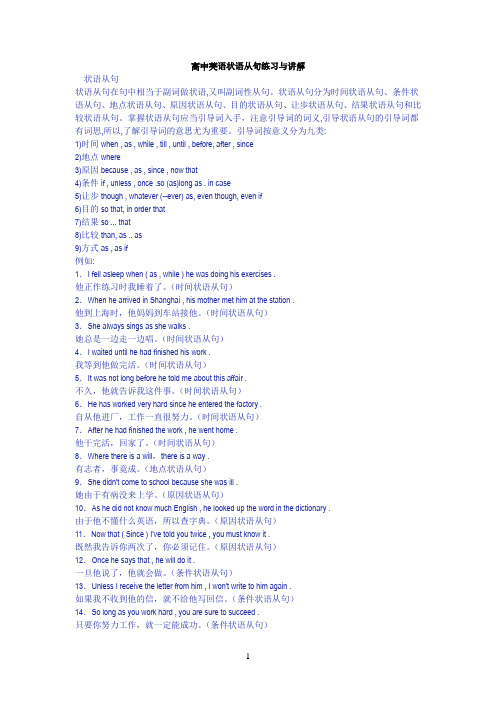
高中英语状语从句练习与讲解状语从句状语从句在句中相当于副词做状语,又叫副词性从句。
状语从句分为时间状语从句、条件状语从句、地点状语从句、原因状语从句、目的状语从句、让步状语从句、结果状语从句和比较状语从句。
掌握状语从句应当引导词入手,注意引导词的词义,引导状语从句的引导词都有词思,所以,了解引导词的意思尤为重要。
引导词按意义分为九类:1)时间when , as , while , till , until , before, after , since2)地点where3)原因because , as , since , now that4)条件if , unless , once .so (as)long as . in case5)让步though , whatever (--ever) as, even though, even if6)目的so that, in order that7)结果so ... that8)比较than, as .. as9)方式as , as if例如:1.I fell asleep when ( as , while ) he was doing his exercises .他正作练习时我睡着了。
(时间状语从句)2.When he arrived in Shanghai , his mother met him at the station .他到上海时,他妈妈到车站接他。
(时间状语从句)3.She always sings as she walks .她总是一边走一边唱。
(时间状语从句)4.I waited until he had finished his work .我等到他做完活。
(时间状语从句)5.It was not long before he told me about this affair .不久,他就告诉我这件事。
(时间状语从句)6.He has worked very hard since he entered the factory .自从他进厂,工作一直很努力。
高中英语状语从句练习与讲解含答案
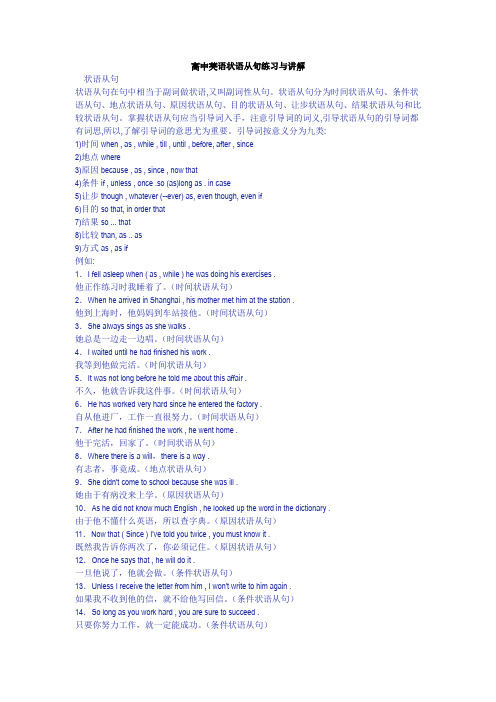
高中英语状语从句练习与讲解状语从句状语从句在句中相当于副词做状语,又叫副词性从句。
状语从句分为时间状语从句、条件状语从句、地点状语从句、原因状语从句、目的状语从句、让步状语从句、结果状语从句和比较状语从句。
掌握状语从句应当引导词入手,注意引导词的词义,引导状语从句的引导词都有词思,所以,了解引导词的意思尤为重要。
引导词按意义分为九类:1)时间when , as , while , till , until , before, after , since2)地点where3)原因because , as , since , now that4)条件if , unless , once .so (as)long as . in case5)让步though , whatever (--ever) as, even though, even if6)目的so that, in order that7)结果so ... that8)比较than, as .. as9)方式as , as if例如:1.I fell asleep when ( as , while ) he was doing his exercises .他正作练习时我睡着了。
(时间状语从句)2.When he arrived in Shanghai , his mother met him at the station .他到上海时,他妈妈到车站接他。
(时间状语从句)3.She always sings as she walks .她总是一边走一边唱。
(时间状语从句)4.I waited until he had finished his work .我等到他做完活。
(时间状语从句)5.It was not long before he told me about this affair .不久,他就告诉我这件事。
(时间状语从句)6.He has worked very hard since he entered the factory .自从他进厂,工作一直很努力。
状语从句讲解及习题附答案
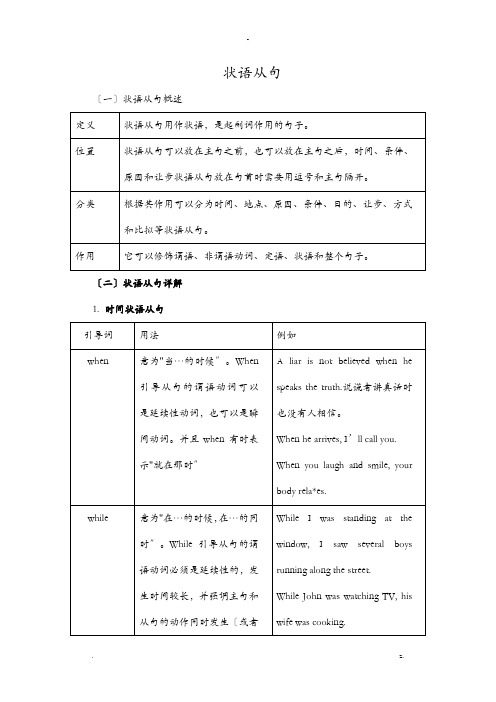
状语从句〔一〕状语从句概述〔二〕状语从句详解1. 时间状语从句2.地点状语从句3.条件状语从句4.原因状语从句5.目的状语从句6.结果状语从句7.让步状语从句8. 比拟状语从句9.方式状语从句练习一一. 单项填空1. _______ he’s old, he can still carry this heavy bag.A. ThoughB. SinceC. ForD. So2. ---Do you know if he _______ to play basketball with us"---I think he will e if he ______ free tomorrow.A. es; isB. es; will beC. will e; isD. will e; will be3. In the zoo if a child _____ into the water and can’t swim, the dolphins may e up ______ him.A. will fall; to helpB. falls; to helpC. will fall; helpD. falls; helping4. I don’t remember ________ he worked in that city when he was young.A. whatB. whichC. whereD. who5. We will stay at home if my aunt ________ to visit us tomorrow.A. esB. eC. will eD. is ing6. The police asked the children _______ cross the street ________ the traffic lights turned green.A. not; beforeB. don’t; whenC. not to; untilD. not; after7. I was late for class yesterday _______ there was something wrong with my bike.A. whenB. thatC. untilD. because8. I’ll go swimming with you if I ________ free tomor row.A. will beB. shall beC. amD. was9. In the e*am, the ________ you are, ______ the _______ mistakes you will make.A. careful; littleB. more careful; fewestC. more careful; fewerD. more careful; less10. You should finish your lessons _______ you go out to play.A. beforeB. afterC. whenD. while11. I hurried _____ I wouldn’t be late for class.A. sinceB. so thatC. as ifD. unless12. When you read the book, you’d better make a mark _______ you have any questions.A. whichB. thatC. whereD. though13. The teacher raised his voice _______ all the students could hear him.A. forB. so thatC. becauseD. in order14. He took off his coat _______ he felt hot.A. becauseB. asC. ifD. since15. It is ______ that we’d like to go out for a walk.A. a lovely dayB. too lovely a dayC. so lovely a dayD. such lovely a day16. Mary had ______ much work to do that she stayed at her office all day.A. suchB. soC. tooD. very17. _______ I felt very tired, I tried to finish the work.A. AlthoughB. BecauseC. AsD. As if18. ______ the day went on, the weather got worse.A. WithB. SinceC. WhileD. As19. ______ well you can drive, you must drive carefully.A. So long asB. In order thatC. No matter howD. The moment20. Write to me as soon as you ________ to Beijing.A. will getB. getC. gettingD. got二. 根据中文意思完成以下英语句子1. 不管他跟我开什么玩笑,我都不生气。
状语从句(9种全)
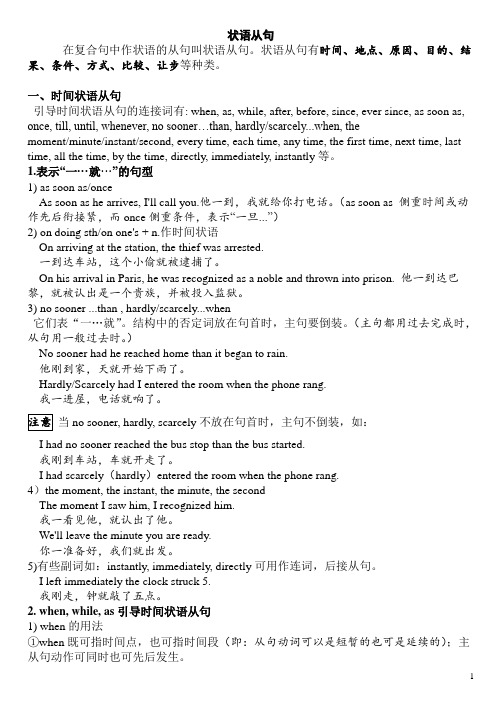
状语从句在复合句中作状语的从句叫状语从句。
状语从句有时间、地点、原因、目的、结果、条件、方式、比较、让步等种类。
一、时间状语从句引导时间状语从句的连接词有: when, as, while, after, before, since, ever since, as soon as, once, till, until, whenever, no sooner…than, hardly/scarcely...when, themoment/minute/instant/second, every time, each time, any time, the first time, next time, last time, all the time, by the time, directly, immediately, instantly等。
1.表示“一···就···”的句型1) as soon as/onceAs soon as he arrives, I'll call you.他一到,我就给你打电话。
(as soon as 侧重时间或动作先后衔接紧,而once侧重条件,表示“一旦...”)2) on doing sth/on one's + n.作时间状语On arriving at the station, the thief was arrested.一到达车站,这个小偷就被逮捕了。
On his arrival in Paris, he was recognized as a noble and thrown into prison. 他一到达巴黎,就被认出是一个贵族,并被投入监狱。
3) no sooner ...than , hardly/scarcely...when它们表“一…就”。
结构中的否定词放在句首时,主句要倒装。
状语从句[含练习和答案解析]
![状语从句[含练习和答案解析]](https://img.taocdn.com/s3/m/4f79b1a6eefdc8d376ee32f5.png)
第十二讲状语从句(含练习与答案)担任状语的从句叫状语从句,可以用来表示时间、地点、原因、目的、结果、条件、方式、比较、让步等。
一、时间状语从句:引导词有after,before,as,once,since,till,until,when,whenever,while,as soon as,the moment/minute…(一…就),the time, the day, every time, next time, each time,by the time ,no sooner…than(一…就),hardly(scarcely)…when(一…就)immediately/directly等.Each/Every time he comes here, he will drop in on me.He was ill last time I saw him.上次我见到他时他病了.Hardly had I got to the office when my wife phoned me to go back home at once.=No sooner had I got to the office than my wife phoned me to go home at once.I recognized him immediately I saw him.※ when, while与 as当主句动作时瞬时的,从句动作是延续的,三者都可以用。
when引导的从句动词可以是延续性的或短暂性的,在“be…when…”句式中when表“at that time(就在这时)”意。
while引导的从句中动词必须是延续性的;有时并不表示时间,而表示对比,意“而”、“却”,并列连词,表对照。
As 强调主、从句动作同时或几乎同时发生,意为“一边…一边…”。
When I got home I found the door locked.While / When / as we were working in the fields, it suddenly began to rain.He was wandering through the streets when a bike hit him.I was about to go out when the telephone rang.I had just arrived at school when my wife phoned me to go home.His pencil is red, while mine is yellow.John sang happily as he went along.※ till与until一般情况下可以互换,但until可以位于句首,till则不能。
初中英语原因目的和结果状语从句详解

初中英语原因目的和结果状语从句详解原因状语从句(Adverbial clause of reason)是表示一个动作或情况的原因或理由的从句。
目的状语从句(Adverbial clause of purpose)是表示一个动作或情况的目的或意图的从句。
结果状语从句(Adverbial clause of result)是表示一个动作或情况的结果或后果的从句。
详细解释如下:1. 原因状语从句(Adverbial clause of reason):原因状语从句回答“为什么?”的问题,说明动作或情况的原因或理由。
原因状语从句通常由连词because、since、as、now that、seeing that等引导。
例句:- I couldn't sleep because it was too noisy.(我不能入睡,因为太吵了。
)- Since it was raining heavily, we stayed indoors.(由于下着大雨,我们呆在室内。
)2. 目的状语从句(Adverbial clause of purpose):目的状语从句回答“为了什么?”的问题,说明动作或情况的目的或意图。
目的状语从句通常由连词so that、in order that、for the purpose of等引导。
例句:- I study hard so that I can get good grades.(我努力学习,以便能取得好成绩。
)- I bought a ticket for the concert so that I could see my favorite singer.(我买了一张音乐会的票,为了能看到我最喜欢的歌手。
)3. 结果状语从句(Adverbial clause of result):结果状语从句回答“怎么样?”的问题,说明动作或情况的结果或后果。
结果状语从句通常由连词so、such...that、enough等引导。
原因、目的、结果状语从句精讲
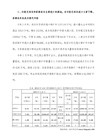
1) The teacher’s teaching was so interesting that all the students were very excited.
老师讲课非常有趣,学生们都感到很兴奋。
2) Jack studies so hard that he always makes progress.
刘先生由于初来乍到,因此在这儿没有太多的朋友。
since语气较弱。它所引导的从句一般放在主句之前,意为“既然”;就对方陈述的事实作为理由。
例:
1) Since Li Ming doesn’t know the answers to the problems, let’s ask Wang Lei to do it.
我把窗户打开以便新鲜空气可以进来。
3) We will tell you everything about it soon in order that you can prepare for that.
不久我们将会让你知道详情,以便你能够做准备。(目的)
三、结果状语从句通常由连词so…that, such…that引导。二者都表示“如此…以至于”之意。
我爷爷心地善良,大家都喜欢和他聊天。
2) It is so cold that I have to wear warm clothes.
(= It is such cold weather that I have to wear warm clothes.)
天气如此的冷,以至于我不得不穿上暖和的衣服。
杰克学习很是努力,结果他不断取得进步。
3) It’s such a nice day that all of us want to go camping.
- 1、下载文档前请自行甄别文档内容的完整性,平台不提供额外的编辑、内容补充、找答案等附加服务。
- 2、"仅部分预览"的文档,不可在线预览部分如存在完整性等问题,可反馈申请退款(可完整预览的文档不适用该条件!)。
- 3、如文档侵犯您的权益,请联系客服反馈,我们会尽快为您处理(人工客服工作时间:9:00-18:30)。
状语从句总结一、原因状语从句(1)原因状语从句通常由because, since, as, for引导。
(2)because表示直接原因,语气最强。
because引导的原因状语从句多放在主句之后。
回答由why提出的问题,只能用because。
此外,because和so不能同用在一个句子里。
例如:------Why aren’t going there------Because I don’t want to.since引导原因状语从句,相当于now that,意思是“因为……,既然……,鉴于……”。
例如:Since the rain has stopped,let’s go for a walk. 既然雨停了,我们出去散散步吧。
as和since语气较弱,一般用来表示明显的原因。
由as和since引导的原因状语从居多放在句首。
例如:As he has no car, he can’t get there easily.Since we have no money, we can’t buy it.(3)for表示所说的理由是一种补充说明,for引导的从句一般不放在句子的开头。
如:I decided to stop and have lunch, for I was feeling quite hungry.练习:I was late for class yesterday _______ there was something wrong with my bike.He took off his coat _______ he felt hot.you can’t answer the question, I’ll ask someone else.二、结果状语从句(1)结果状语从句由so…that, such…that, so that引导。
(2)so…that语such...that可以互换。
在由so...that引导的结果状语从句中,so是副词,与形容词连用。
其结构是: “...so + 形容词(副词)+ that + 从句”。
例如:He was so glad that he couldn’t say a word.Mother lives so far away that we hardly ever(几乎不,从来不)see her.在由such…that引导的结果状语从句中,such是形容词,它修饰的可以是单数或复数可数名词,也可以是不可数名词;其结构是: “...such +a / an + 形容词+名词+ that + 从句”。
例如:It was such a hot day that nobody wanted to do anything.He had such long arms that he could almost touch the ceiling.(天花板)有时上述两种结构是可以互换的。
例如:It was such a wonderful film that all of us wanted to see it again.=The film was so wonderful that all of us wanted to see it again.(3)如果名词前由many, much, little, few等词修饰时,只能用so, 不用such。
例如:Soon there were so many deer that they ate up all the wild roses.He has so little time that he can’t go to the cinema with you.(4)如果主从句的主语相同,并且从句是否定的形式,可以用too...to...句型转化。
例如:He was so excited that he couldn't go to sleep that night. = Hewas too excited to go to sleep.(5)如果主从句的主语相同,但从句是肯定的形式,可以用adj.+ enough替换。
例如:He is so old that he could go to school. = He is old enough togo to school.他够大了,可以去上学。
练习:It is ___ hot in the room ___ we have to go out for a walk.It was a wonderful movie all of us wanted to see it again.There were little water in the bottle the bird couldn’t reach it..三、目的状语从句(1)目的状语从句通常由 so that, in order that(为了,以便)引导。
例如:We started early so that we could catch the first train.We used the computer in order that we might save time.(2)so that可引导目的状语从句,此时可用to或in order to替换,将其改为简单句。
例如:He got up early so that he could get to school on time.=He got up early(in order) to get to school on time.(3)so that既可引导目的状语从句,又可引导结果状语从句。
区别这两种从句的办法有两个:1)目的状语从句里往往带有情态动词can, could, may,might等。
2)从意思上看,目的状语从句往往表示的目的很明确。
例如: Speak clearly so that they may understand you. (目的状语从句)Jack is badly ill so that he has to rest. (结果状语从句)练习: I hurried I wouldn't be late for class.We should go by bus ___ we can get there earlier.May I sit nearer I can see more clearly(4) 补充:so as to…(肯定结构) eg. He got up early so as to catch the early train.so as not to…(否定结构) eg.He got up early so as not to miss the early train.to…eg. He got up early to catch the early train.in order that …eg. He got up early in order that he could catch the early train.in order to…eg. He got up early in order to catch the early train.Translateso that 以便;为了他阅读更多书,以便他能知道更多知识。
我们努力学习是为了我们能有一个好的未来我起得早是为了能赶上早一点的班车。
请打开窗户以便我们能呼吸新鲜空气。
你现在一定要走是为了不迟到。
小男孩节省每一个硬币是为了他能在母亲节给他妈妈买一份礼物。
她在网上购买了一部手机以便她能打电话。
说得清楚些,使得他们能听懂你的意思.拿近一些,好让我看得更清楚些。
我们现在就准备好,等父亲一来我们就可以走了。
so...that... 如此(太)……以致……我太累了,以致我一吃完晚饭就去睡觉了。
她太漂亮了以致很多人喜欢她。
咖啡太热了以致于我现在不能喝。
她如此年轻以致她不能照顾好她自己。
男孩跑得太快了以致我不能追上他。
他太饿了以致他不能说一个字。
男人太强壮了以致他可以抬起这个重箱子。
箱子太轻了以致他能背起它。
他病得很厉害,今天无法上学。
这个小孩以前经常撒谎,以至于现在没有人相信他。
她很伤心以至于她伤心地哭了。
那门太小了,以至于这只熊走不进去。
Translate answersso that 以便;为了他阅读更多书,以便他能知道更多知识。
He reads more books so that he can lean more knowledge.我们努力学习是为了我们能有一个好的未来 We study hard so that we can have a good future.我起得早是为了能赶上早一点的班车。
I got up early so that I could catch the early bus.请打开窗户以便我们能呼吸新鲜空气。
Please open the window so that we can breathe fresh air.你现在一定要走是为了不迟到。
You must go now so that you won't be late.小男孩节省每一个硬币是为了他能在母亲节给他妈妈买一份礼物。
The little boy saved every coin so that he could buy his mother a present on Mother's day.她在网上购买了一部手机以便她能打电话。
I’ll give you all the facts so that you can judge for your self.说得清楚些,使得他们能听懂你的意思. Speak clearly, so that they may understand you.拿近一些,好让我看得更清楚些。
Bring it nearer so that I may see it better.我们现在就准备好,等父亲一来我们就可以走了。
Let's get ready now so that we can leave when Father comes.so...that... 如此(太)……以致……我太累了,以致我一吃完晚饭就去睡觉了。
I was so tired that I went to bed as soon as I had supper.她太漂亮了以致很多人喜欢她。
She is so beautiful that many people like her.咖啡太热了以致于我现在不能喝。
